ignition ASTON MARTIN V8 VANTAGE 2010 Repair Manual
[x] Cancel search | Manufacturer: ASTON MARTIN, Model Year: 2010, Model line: V8 VANTAGE, Model: ASTON MARTIN V8 VANTAGE 2010Pages: 947, PDF Size: 43.21 MB
Page 837 of 947
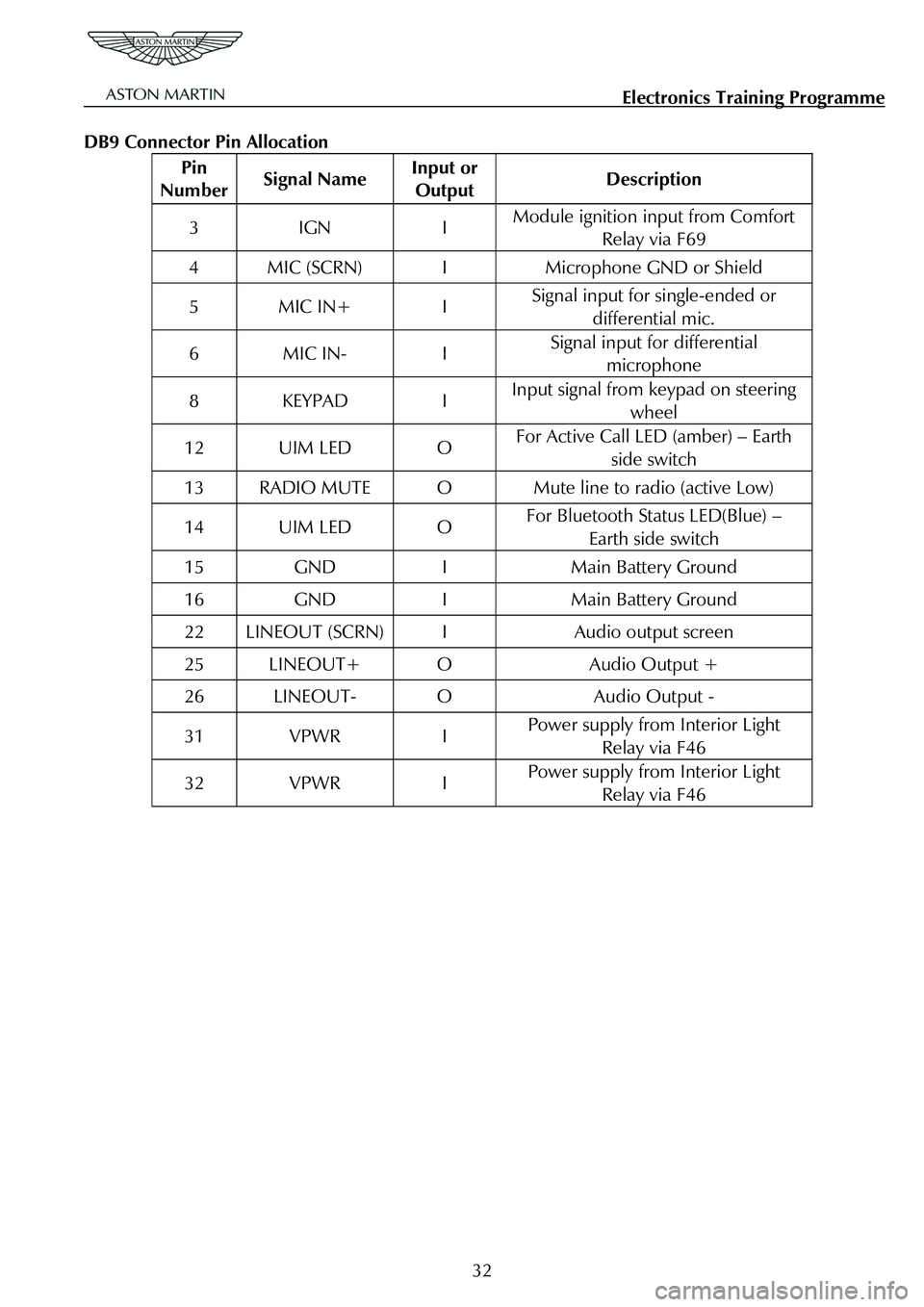
Electronics Training Programme
DB9 Connector Pin Allocation
Pin
Number Signal Name Input or
Output Description
3 IGN I Module ignition input from Comfort
Relay via F69
4 MIC (SCRN) I Microphone GND or Shield
5 MIC IN+ I Signal input for single-ended or
differential mic.
6 MIC IN- I Signal input for differential microphone
8 KEYPAD I Input signal from keypad on steering
wheel
12 UIM LED O For Active Call LED (amber) – Earth side switch
13 RADIO MUTE O Mute line to radio (active Low)
14 UIM LED O For Bluetooth Status LED(Blue) – Earth side switch
15 GND I Main Battery Ground
16 GND I Main Battery Ground
22 LINEOUT (SCRN) I Audio output screen
25 LINEOUT+ O Audio Output +
26 LINEOUT- O Audio Output -
31 VPWR I Power supply from Interior Light Relay via F46
32 VPWR I Power supply from Interior Light Relay via F46
32
Page 851 of 947
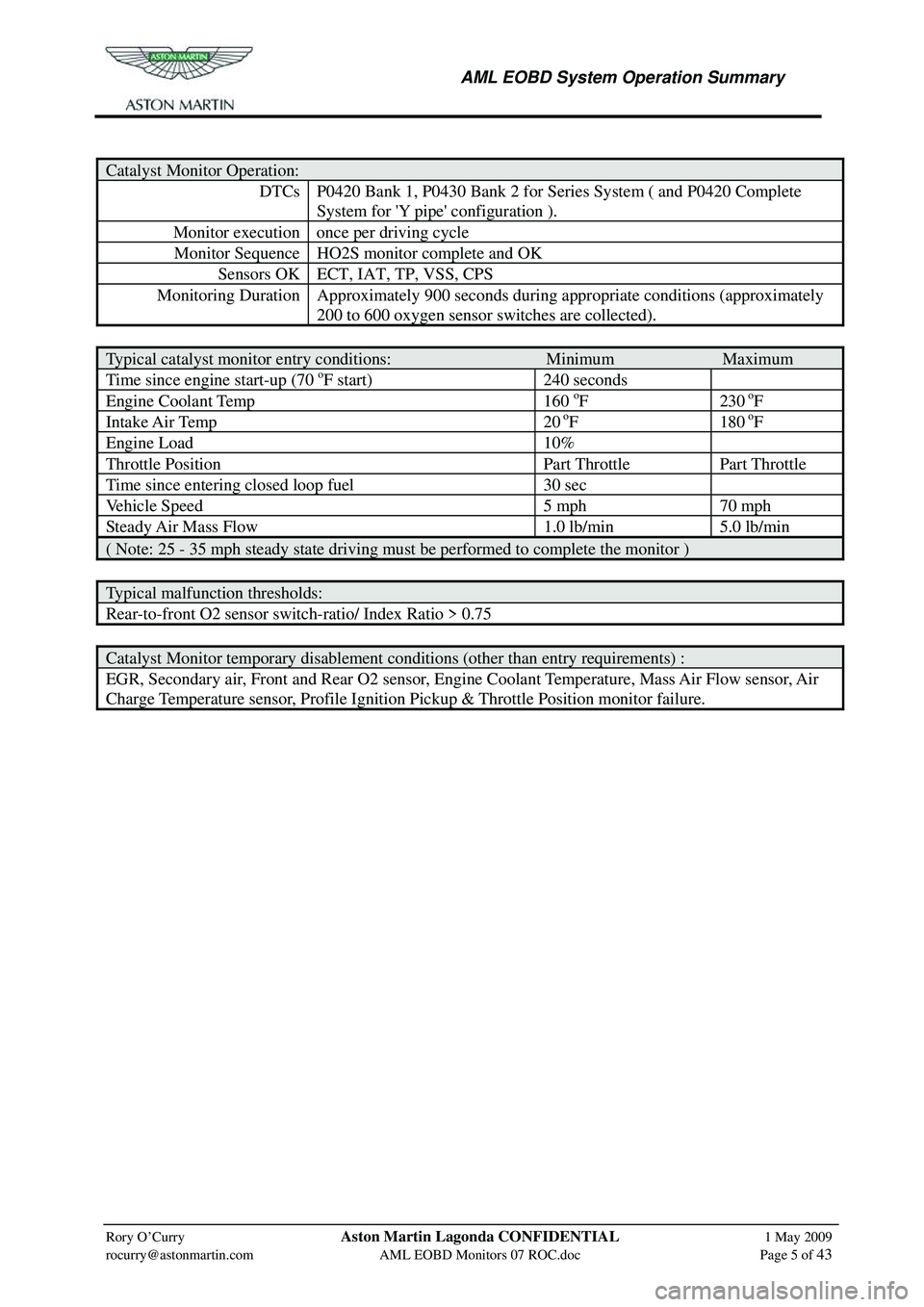
AML EOBD System Operation Summary
Rory O’Curry Aston Martin Lagonda CONFIDENTIAL 1 May 2009
[email protected] AML EOBD Monitors 07 ROC.doc Page 5 of 43
Catalyst Monitor Operation:
DTCs P0420 Bank 1, P0430 Bank 2 for Series System ( and P0420 Complete
System for 'Y pipe' configuration ).
Monitor execution once per driving cycle
Monitor Sequence HO2S monitor complete and OK
Sensors OK ECT, IAT, TP, VSS, CPS
Monitoring Duration Approximately 900 seconds dur ing appropriate conditions (approximately
200 to 600 oxygen sensor switches are collected).
Typical catalyst monitor entry conditions: Minimum Maximum
Time since engine start-up (70 oF start) 240 seconds
Engine Coolant Temp 160 oF 230 oF
Intake Air Temp 20 oF 180 oF
Engine Load 10%
Throttle Position Part Throttle Part Throttle
Time since entering closed loop fuel 30 sec
Vehicle Speed 5 mph 70 mph
Steady Air Mass Flow 1.0 lb/min 5.0 lb/min
( Note: 25 - 35 mph steady state driving must be performed to complete the monitor )
Typical malfunction thresholds:
Rear-to-front O2 sensor switch-ratio/ Index Ratio > 0.75
Catalyst Monitor temporary disablement conditions (other than entry requirements) :
EGR, Secondary air, Front and Rear O2 sensor, Engine Coolant Temperature, Mass Air Flow sensor, Air
Charge Temperature sensor, Profile Ignition Pickup & Throttle Position monitor failure.
Page 871 of 947
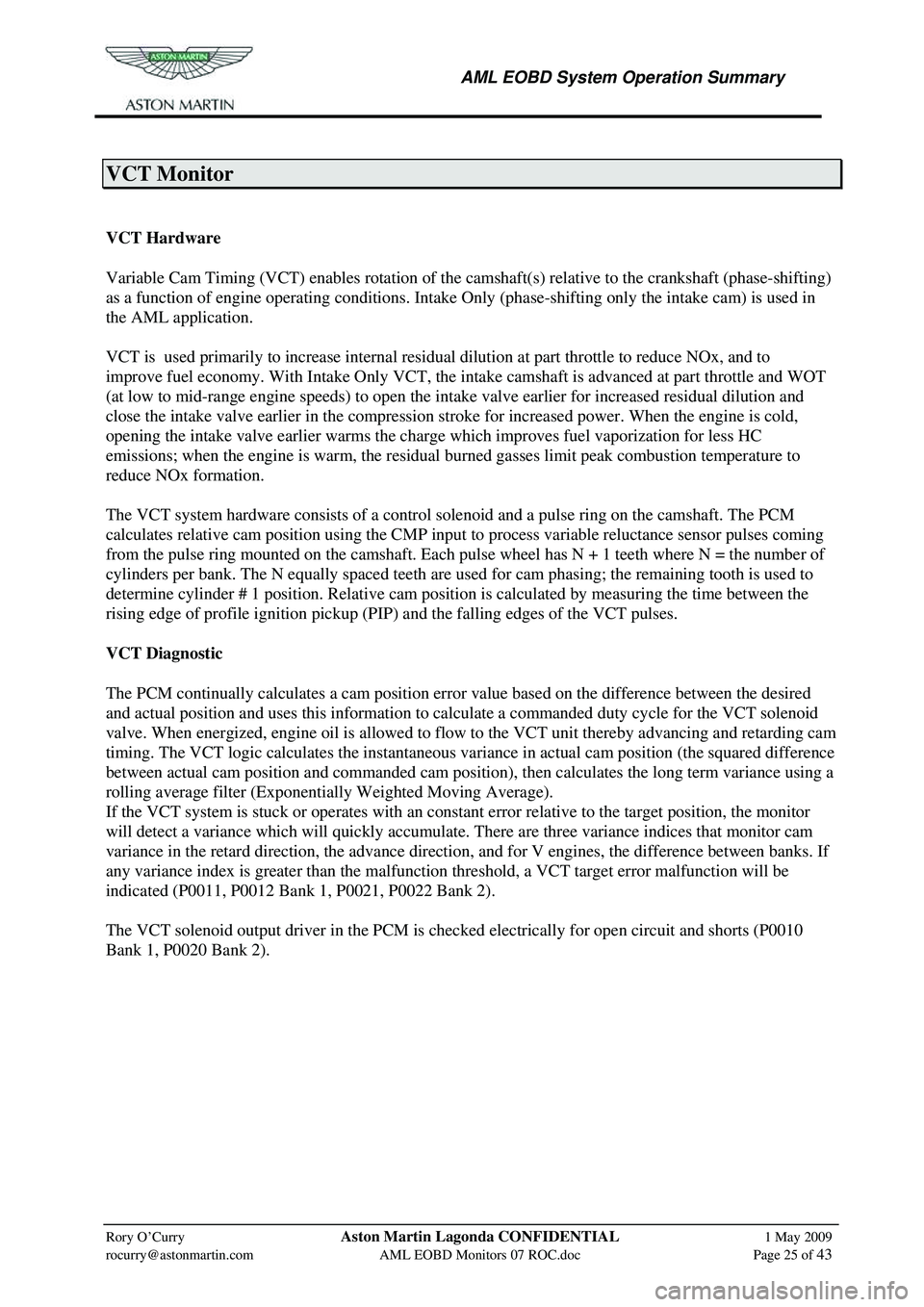
AML EOBD System Operation Summary
Rory O’Curry Aston Martin Lagonda CONFIDENTIAL 1 May 2009
[email protected] AML EOBD Monitors 07 ROC.doc Page 25 of 43
VCT Monitor
Variable Cam Timing System Monitor
VCT Hardware
Variable Cam Timing (VCT) enables rotation of the camshaft(s) relative to the crankshaft (phase-shifting)
as a function of engine operating conditions. Intake Only (phase-shifting only the intake cam) is used in
the AML application.
VCT is used primarily to increase internal residua l dilution at part throttle to reduce NOx, and to
improve fuel economy. With Intake Only VCT, the in take camshaft is advanced at part throttle and WOT
(at low to mid-range engine speeds) to open the in take valve earlier for increased residual dilution and
close the intake valve earlier in the compression stroke for increased power. When the engine is cold,
opening the intake valve earlier warms the charge which improves fuel vaporization for less HC
emissions; when the engine is warm, the residua l burned gasses limit peak combustion temperature to
reduce NOx formation.
The VCT system hardware consists of a contro l solenoid and a pulse ring on the camshaft. The PCM
calculates relative cam position using the CMP input to process variable reluctance sensor pulses coming
from the pulse ring mounted on the camshaft. Each pul se wheel has N + 1 teeth where N = the number of
cylinders per bank. The N equally spaced teeth are used for cam phasing; the remaining tooth is used to
determine cylinder # 1 position. Relative cam position is calculated by measuring the time between the
rising edge of profile ignition pickup (PIP ) and the falling edges of the VCT pulses.
VCT Diagnostic
The PCM continually calculates a cam position error value based on the difference between the desired
and actual position and uses this information to cal culate a commanded duty cycle for the VCT solenoid
valve. When energized, engine oil is allowed to flow to the VCT unit thereby advancing and retarding cam
timing. The VCT logic calculates the instantaneous va riance in actual cam position (the squared difference
between actual cam position and commanded cam position), then calculates the long term variance using a
rolling average filter (Exponentially Weighted Moving Average).
If the VCT system is stuck or operates with an consta nt error relative to the target position, the monitor
will detect a variance which will quickly accumulate. There are three variance indices that monitor cam
variance in the retard direction, the advance directi on, and for V engines, the difference between banks. If
any variance index is greater than the malfunction threshold, a VCT target error malfunction will be
indicated (P0011, P0012 Bank 1, P0021, P0022 Bank 2).
The VCT solenoid output driver in the PCM is check ed electrically for open circuit and shorts (P0010
Bank 1, P0020 Bank 2).
VCT Monitor Operation:
Page 873 of 947
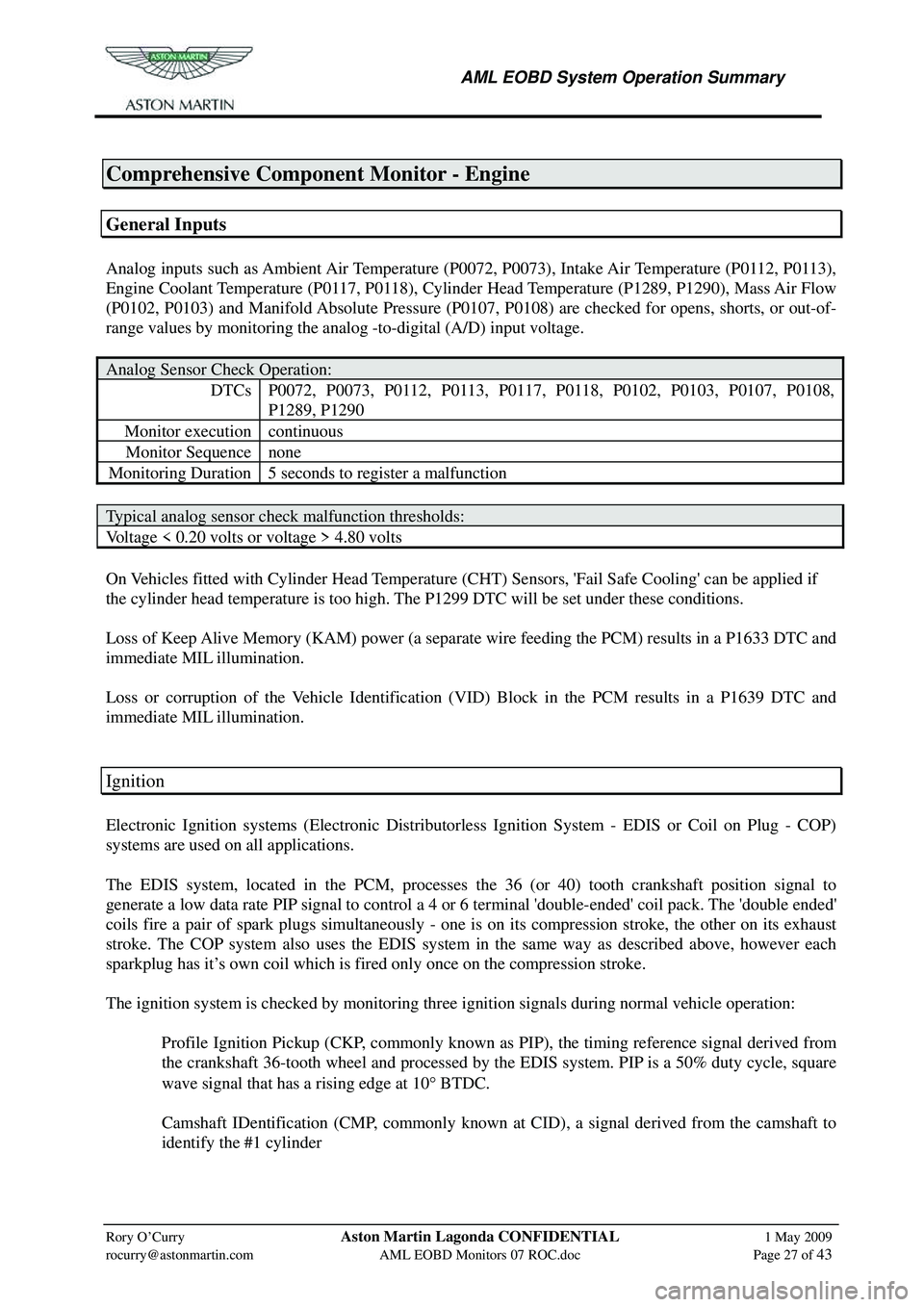
AML EOBD System Operation Summary
Rory O’Curry Aston Martin Lagonda CONFIDENTIAL 1 May 2009
[email protected] AML EOBD Monitors 07 ROC.doc Page 27 of 43
Comprehensive Component Monitor - Engine
General Inputs
Analog inputs such as Ambient Air Temperature (P0072, P0073), Intake Air Temperature (P0112, P0113),
Engine Coolant Temperature (P0117, P0118), Cylinder Head Temperature (P1289, P1290), Mass Air Flow
(P0102, P0103) and Manifold Absolute Pressure (P0107, P0108) are checked for opens, shorts, or out-of-
range values by monitoring the analog -to-digital (A/D) input voltage.
Analog Sensor Check Operation:
DTCs P0072, P0073, P0112, P0113, P0117, P0118, P0102, P0103, P0107, P0108,
P1289, P1290
Monitor execution continuous
Monitor Sequence none
Monitoring Duration 5 seconds to register a malfunction
Typical analog sensor check malfunction thresholds:
Voltage < 0.20 volts or voltage > 4.80 volts
On Vehicles fitted with Cylinder Head Temperature (CHT ) Sensors, 'Fail Safe Cooling' can be applied if
the cylinder head temperature is too high. The P1299 DTC will be set under these conditions.
Loss of Keep Alive Memory (KAM) power (a separate wire feeding the PCM) results in a P1633 DTC and
immediate MIL illumination.
Loss or corruption of the Vehicle Identification (VID) Block in the PCM results in a P1639 DTC and
immediate MIL illumination.
Ignition
Electronic Ignition systems (Electronic Distributorless Ignition System - EDIS or Coil on Plug - COP)
systems are used on all applications.
The EDIS system, located in the PCM, processes the 36 (or 40) tooth crankshaft position signal to
generate a low data rate PIP signal to control a 4 or 6 terminal 'double-ended' coil pack. The 'double ended'
coils fire a pair of spark plugs simultaneously - one is on its compression stroke, the other on its exhaust
stroke. The COP system also uses the EDIS system in the same way as described above, however each
sparkplug has it’s own coil which is fired only once on the compression stroke.
The ignition system is checked by monitoring three ignition signals during normal vehicle operation:
Profile Ignition Pickup (CKP, commonly known as PIP), the timing reference signal derived from the crankshaft 36-tooth wheel and processed by the EDIS system. PIP is a 50% duty cycle, square
wave signal that has a rising edge at 10 ° BTDC.
Camshaft IDentification (CMP, commonly known at CID), a signal derived from the camshaft to identify the #1 cylinder
Page 874 of 947
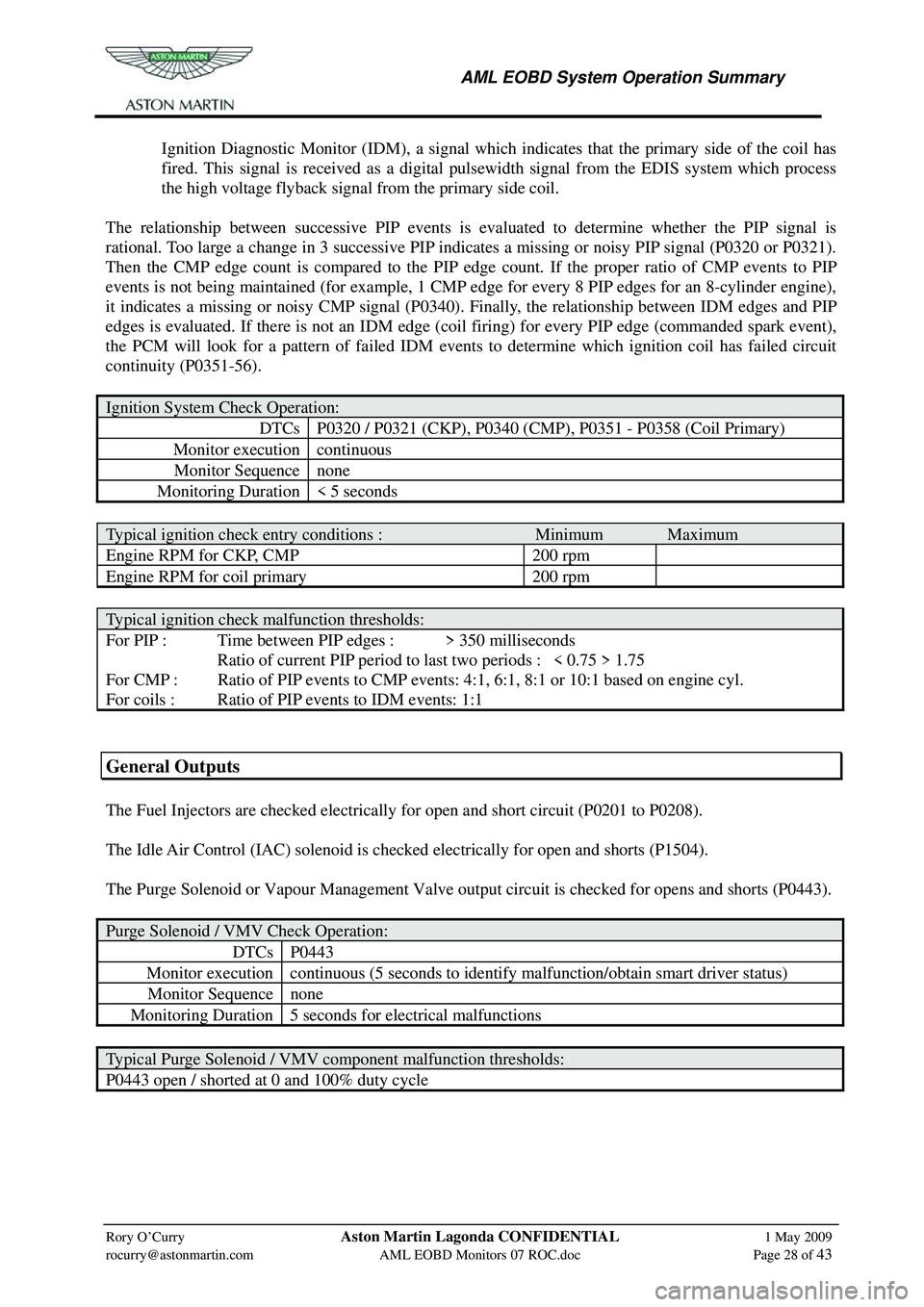
AML EOBD System Operation Summary
Rory O’Curry Aston Martin Lagonda CONFIDENTIAL 1 May 2009
[email protected] AML EOBD Monitors 07 ROC.doc Page 28 of 43
Ignition Diagnostic Monitor (IDM), a signal which indicates that the primary side of the coil has
fired. This signal is received as a digital pulsewidth signal from the EDIS system which process
the high voltage flyback signal from the primary side coil.
The relationship between successive PIP events is ev aluated to determine whether the PIP signal is
rational. Too large a change in 3 successive PIP indicates a missing or noisy PIP signal (P0320 or P0321).
Then the CMP edge count is compared to the PIP e dge count. If the proper ratio of CMP events to PIP
events is not being maintained (for example, 1 CMP e dge for every 8 PIP edges for an 8-cylinder engine),
it indicates a missing or noisy CMP signal (P0340). Finally, the relationship between IDM edges and PIP
edges is evaluated. If there is not an IDM edge (co il firing) for every PIP edge (commanded spark event),
the PCM will look for a pattern of failed IDM events to determine which ignition coil has failed circuit
continuity (P0351-56).
Ignition System Check Operation:
DTCs P0320 / P0321 (CKP), P0340 (CMP), P0351 - P0358 (Coil Primary)
Monitor execution continuous
Monitor Sequence none
Monitoring Duration < 5 seconds
Typical ignition check entry conditions : Minimum Maximum
Engine RPM for CKP, CMP 200 rpm
Engine RPM for coil primary 200 rpm
Typical ignition check malfunction thresholds:
For PIP : Time between PIP edges : > 350 milliseconds
Ratio of current PIP period to last two periods : < 0.75 > 1.75
For CMP : Ratio of PIP events to CMP events: 4:1, 6:1, 8:1 or 10:1 based on engine cyl.
For coils : Ratio of PIP events to IDM events: 1:1
General Outputs
The Fuel Injectors are checked electrically for open and short circuit (P0201 to P0208).
The Idle Air Control (IAC) solenoid is checked electrically for open and shorts (P1504).
The Purge Solenoid or Vapour Management Valve output circuit is checked for opens and shorts (P0443).
Purge Solenoid / VMV Check Operation:
DTCsP0443
Monitor execution continuous (5 seconds to identify malfunction/obtain smart driver status)
Monitor Sequencenone
Monitoring Duration 5 seconds for electrical malfunctions
Typical Purge Solenoid / VMV component malfunction thresholds:
P0443 open / shorted at 0 and 100% duty cycle
Page 883 of 947
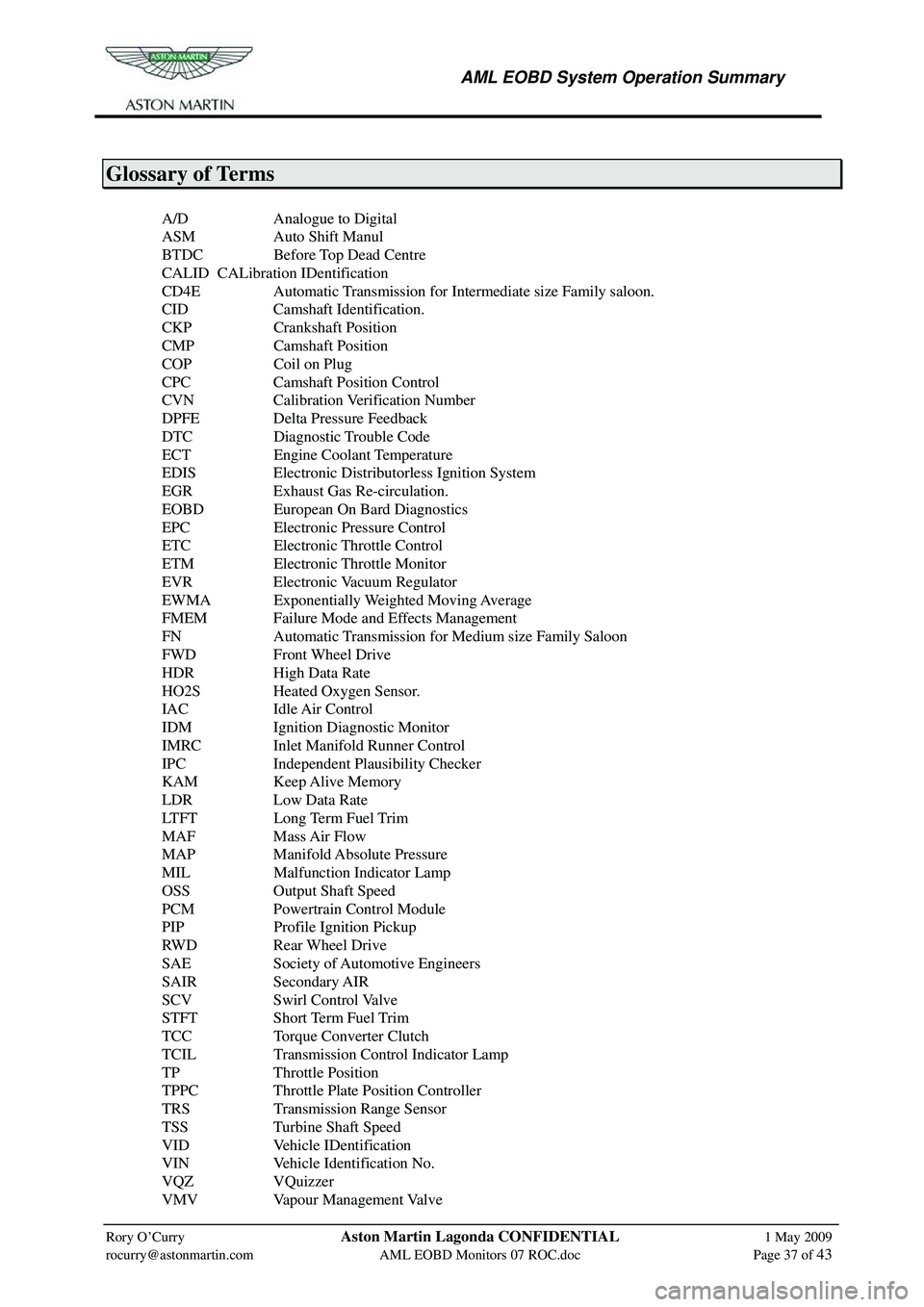
AML EOBD System Operation Summary
Rory O’Curry Aston Martin Lagonda CONFIDENTIAL 1 May 2009
[email protected] AML EOBD Monitors 07 ROC.doc Page 37 of 43
Glossary of Terms
A/D Analogue to Digital
ASM Auto Shift Manul
BTDC Before Top Dead Centre
CALID CALibration IDentification
CD4E Automatic Transmission for Intermediate size Family saloon.
CID Camshaft Identification.
CKP Crankshaft Position
CMP Camshaft Position
COP Coil on Plug
CPC Camshaft Position Control
CVN Calibration Verification Number
DPFE Delta Pressure Feedback
DTC Diagnostic Trouble Code
ECT Engine Coolant Temperature
EDIS Electronic Distributorless Ignition System
EGR Exhaust Gas Re-circulation.
EOBD European On Bard Diagnostics
EPC Electronic Pressure Control
ETC Electronic Throttle Control
ETM Electronic Throttle Monitor
EVR Electronic Vacuum Regulator
EWMA Exponentially Weighted Moving Average
FMEM Failure Mode and Effects Management
FN Automatic Transmission for Medium size Family Saloon
FWD Front Wheel Drive
HDR High Data Rate
HO2S Heated Oxygen Sensor.
IAC Idle Air Control
IDM Ignition Diagnostic Monitor
IMRC Inlet Manifold Runner Control
IPC Independent Plausibility Checker
KAM Keep Alive Memory
LDR Low Data Rate
LTFT Long Term Fuel Trim
MAF Mass Air Flow
MAP Manifold Absolute Pressure
MIL Malfunction Indicator Lamp
OSS Output Shaft Speed
PCM Powertrain Control Module
PIP Profile Ignition Pickup
RWD Rear Wheel Drive
SAE Society of Automotive Engineers
SAIR Secondary AIR
SCV Swirl Control Valve
STFT Short Term Fuel Trim
TCC Torque Converter Clutch
TCIL Transmission Control Indicator Lamp
TP Throttle Position
TPPC Throttle Plate Position Controller
TRS Transmission Range Sensor
TSS Turbine Shaft Speed
VID Vehicle IDentification
VIN Vehicle Identification No.
VQZ VQuizzer
VMV Vapour Management Valve
Page 885 of 947
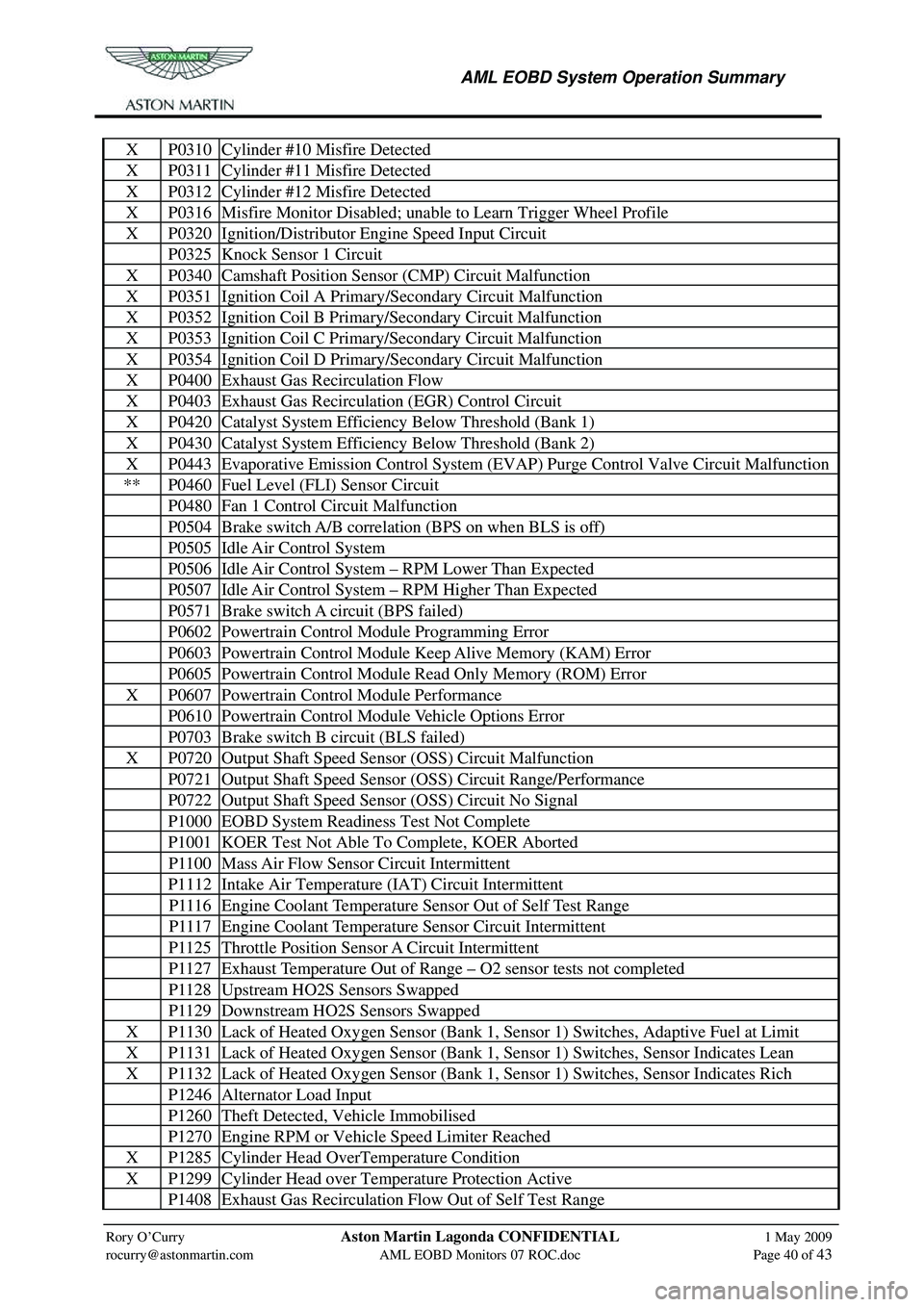
AML EOBD System Operation Summary
Rory O’Curry Aston Martin Lagonda CONFIDENTIAL 1 May 2009
[email protected] AML EOBD Monitors 07 ROC.doc Page 40 of 43
X P0310 Cylinder #10 Misfire Detected
X P0311 Cylinder #11 Misfire Detected
X P0312 Cylinder #12 Misfire Detected
X P0316 Misfire Monitor Disabled; unable to Learn Trigger Wheel Profile
X P0320 Ignition/Distributor Engine Speed Input Circuit
P0325 Knock Sensor 1 Circuit
X P0340 Camshaft Position Sens or (CMP) Circuit Malfunction
X P0351 Ignition Coil A Primary/Secondary Circuit Malfunction
X P0352 Ignition Coil B Primary/Secondary Circuit Malfunction
X P0353 Ignition Coil C Primary/Secondary Circuit Malfunction
X P0354 Ignition Coil D Primary/Secondary Circuit Malfunction
X P0400 Exhaust Gas Recirculation Flow
X P0403 Exhaust Gas Recirculation (EGR) Control Circuit
X P0420 Catalyst System Efficiency Below Threshold (Bank 1)
X P0430 Catalyst System Efficiency Below Threshold (Bank 2)
X P0443 Evaporative Emission Control System (EVAP) Purge Control Valve Circuit Malfunction
** P0460 Fuel Level (FLI) Sensor Circuit
P0480 Fan 1 Control Circuit Malfunction
P0504 Brake switch A/B correlation (BPS on when BLS is off)
P0505 Idle Air Control System
P0506 Idle Air Control System – RPM Lower Than Expected
P0507 Idle Air Control System – RPM Higher Than Expected
P0571 Brake switch A circuit (BPS failed)
P0602 Powertrain Control Module Programming Error
P0603 Powertrain Control Module Keep Alive Memory (KAM) Error
P0605 Powertrain Control Module Read Only Memory (ROM) Error
X P0607 Powertrain Control Module Performance
P0610 Powertrain Control Module Vehicle Options Error
P0703 Brake switch B circuit (BLS failed)
X P0720 Output Shaft Speed Sensor (OSS) Circuit Malfunction
P0721 Output Shaft Speed Sensor (OSS) Circuit Range/Performance
P0722 Output Shaft Speed Sensor (OSS) Circuit No Signal
P1000 EOBD System Readiness Test Not Complete
P1001 KOER Test Not Able To Complete, KOER Aborted
P1100 Mass Air Flow Sensor Circuit Intermittent
P1112 Intake Air Temperature (IAT) Circuit Intermittent
P1116 Engine Coolant Temperature Sensor Out of Self Test Range
P1117 Engine Coolant Temperature Sensor Circuit Intermittent
P1125 Throttle Position Sensor A Circuit Intermittent
P1127 Exhaust Temperature Out of Range – O2 sensor tests not completed
P1128 Upstream HO2S Sensors Swapped
P1129 Downstream HO2S Sensors Swapped
X P1130 Lack of Heated Oxygen Sensor (Bank 1, Sensor 1) Switches, Adaptive Fuel at Limit
X P1131 Lack of Heated Oxygen Sensor (Bank 1, Sensor 1) Switches, Sensor Indicates Lean
X P1132 Lack of Heated Oxygen Sensor (Bank 1, Sensor 1) Switches, Sensor Indicates Rich
P1246 Alternator Load Input
P1260 Theft Detected, Vehicle Immobilised
P1270 Engine RPM or Vehicle Speed Limiter Reached
X P1285 Cylinder Head OverTemperature Condition
X P1299 Cylinder Head over Temperature Protection Active
P1408 Exhaust Gas Recirculation Flow Out of Self Test Range
Page 899 of 947
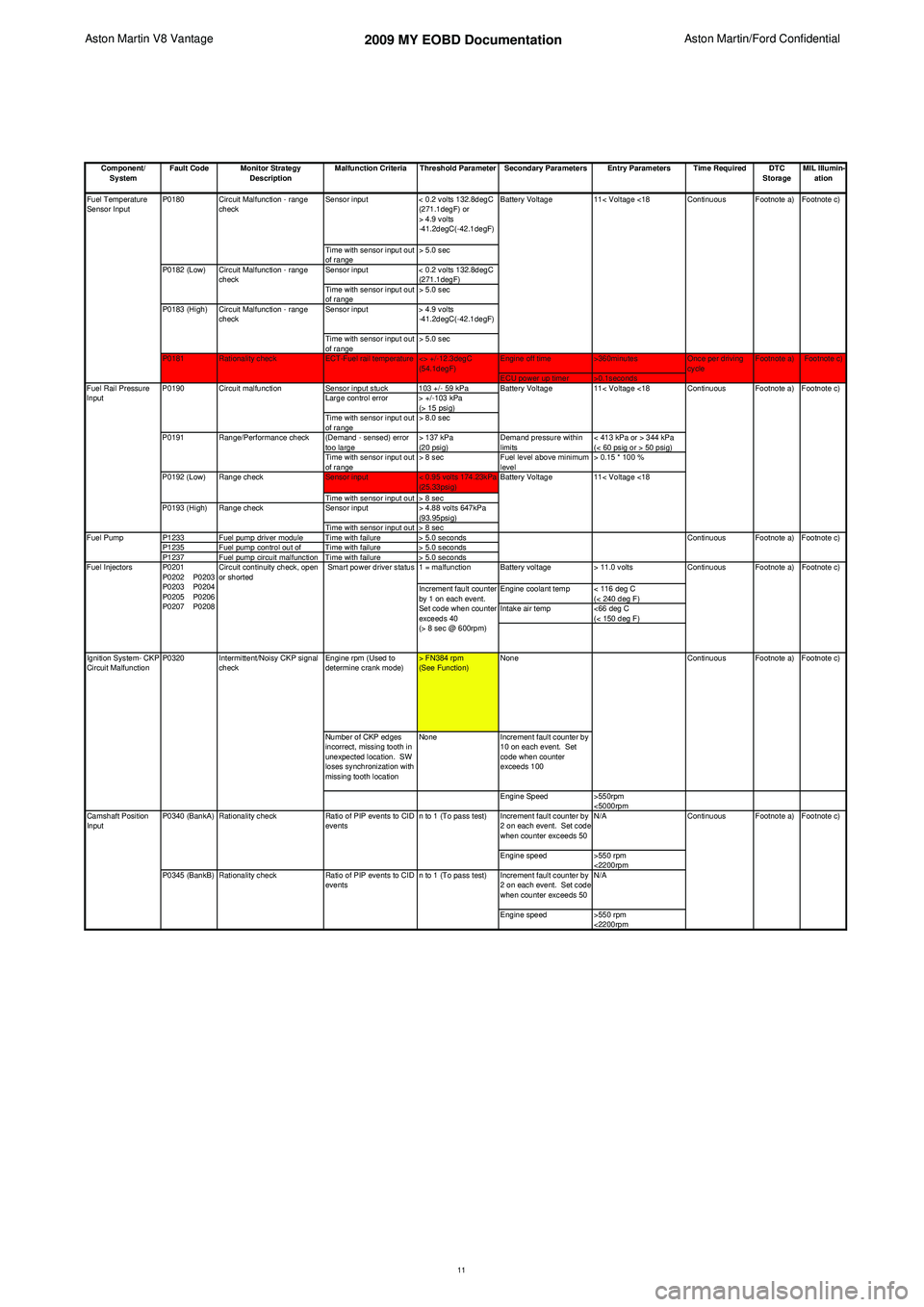
Aston Martin V8 Vantage 2009 MY EOBD DocumentationAston Martin/Ford Confidential
Component/ System Fault Code Monitor Strategy
Description Malfunction Criteria Threshold Parameter Secondary Parameters Entry Parameters Time Required DTC
StorageMIL Illumin-
ation
Sensor input < 0.2 volts 132.8degC
(271.1degF) or
> 4.9 volts
-41.2degC(-42.1degF)
Time with sensor input out
of range > 5.0 sec
Sensor input < 0.2 volts 132.8degC
(271.1degF)
Time with sensor input out
of range > 5.0 sec
Sensor input > 4.9 volts
-41.2degC(-42.1degF)
Time with sensor input out
of range > 5.0 sec
Engine off time >360minutes
ECU power up timer >0.1seconds
Sensor input stuck 103 +/- 59 kPa
Large control error > +/-103 kPa (> 15 psig)
Time with sensor input out
of range > 8.0 sec
(Demand - sensed) error
too large > 137 kPa
(20 psig)Demand pressure within
limits < 413 kPa or > 344 kPa
(< 60 psig or > 50 psig)
Time with sensor input out
of range > 8 sec
Fuel level above minimum
level > 0.15 * 100 %
Sensor input < 0.95 volts 174.23kPa
(25.33psig)
Time with sensor input out > 8 sec
Sensor input > 4.88 volts 647kPa
(93.95psig)
Time with sensor input out > 8 sec
P1233 Fuel pump driver module Time with failure > 5.0 seconds
P1235 Fuel pump control out of Time with failure > 5.0 seconds
P1237 Fuel pump circuit malfunction Time with failure > 5.0 seconds 1 = malfunction Battery voltage> 11.0 volts
Engine coolant temp < 116 deg C (< 240 deg F)
Intake air temp <66 deg C
(< 150 deg F)
Engine rpm (Used to
determine crank mode) > FN384 rpm
(See Function)None
Number of CKP edges
incorrect, missing tooth in
unexpected location. SW
loses synchronization with
missing tooth location None
Increment fault counter by
10 on each event. Set
code when counter
exceeds 100
Engine Speed >550rpm
<5000rpm
Increment fault counter by
2 on each event. Set code
when counter exceeds 50 N/A
Engine speed >550 rpm
<2200rpm
Increment fault counter by
2 on each event. Set code
when counter exceeds 50 N/A
Engine speed >550 rpm
<2200rpm Footnote a) Footnote c)
Continuous
<> +/-12.3degC
(54.1degF) Once per driving
cycle
Fuel Temperature
Sensor Input
ECT-Fuel rail temperature
Circuit Malfunction - range
check
Circuit Malfunction - range
check
Circuit Malfunction - range
check
P0180
P0182 (Low)
P0181 Rationality check
P0183 (High)
Ignition System- CKP
Circuit Malfunction P0320 Intermittent/Noisy CKP signal
check Footnote c)
Footnote c)
Ratio of PIP events to CID
events Continuous Footnote a) Footnote c)
n to 1 (To pass test)
n to 1 (To pass test)
Increment fault counter
by 1 on each event.
Set code when counter
exceeds 40
(> 8 sec @ 600rpm)
Smart power driver status
P0340 (BankA)
P0345 (BankB) Circuit continuity check, open
or shorted
P0201
P0202 P0203
P0203 P0204
P0205 P0206
P0207 P0208
Camshaft Position
Input Rationality check
Rationality checkRatio of PIP events to CID
events Continuous
Footnote a)
Footnote c)
Continuous Footnote a) Footnote c) Footnote a)
Battery Voltage 11< Voltage <18
11< Voltage <18 Continuous Footnote a) Footnote c)
11< Voltage <18
Circuit malfunction
Battery Voltage
Battery Voltage
Range check
Continuous Footnote a)
Fuel Injectors
Fuel Rail Pressure
Input
P0190
P0191
P0192 (Low)
P0193 (High)
Fuel Pump Range check
Range/Performance check
11
Page 900 of 947
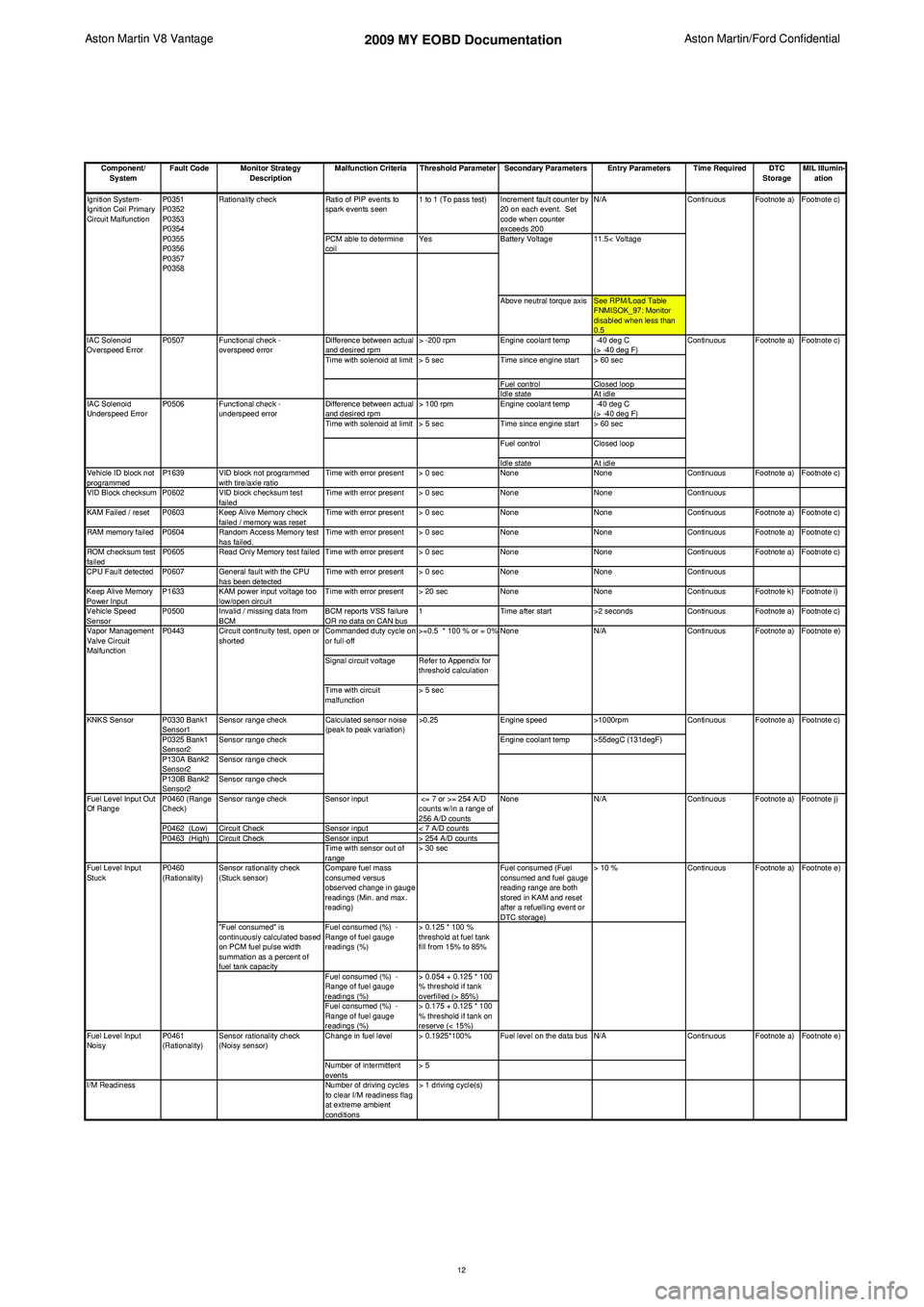
Aston Martin V8 Vantage 2009 MY EOBD DocumentationAston Martin/Ford Confidential
Component/ System Fault Code Monitor Strategy
Description Malfunction Criteria Threshold Parameter Secondary Parameters Entry Parameters Time Required DTC
StorageMIL Illumin-
ation
Ratio of PIP events to
spark events seen 1 to 1 (To pass test) Increment fault counter by
20 on each event. Set
code when counter
exceeds 200 N/A
PCM able to determine
coil Yes
Above neutral torque axis See RPM/Load Table FNMISOK_97: Monitor
disabled when less than
0.5
Difference between actual
and desired rpm > -200 rpm
Engine coolant temp -40 deg C
(> -40 deg F)
Time with solenoid at limit > 5 sec Time since engine start > 60 sec
Fuel control Closed loop
Idle state At idle
Difference between actual
and desired rpm > 100 rpm
Engine coolant temp -40 deg C
(> -40 deg F)
Time with solenoid at limit > 5 sec Time since engine start > 60 sec
Fuel control Closed loop
Idle state At idle
Vehicle ID block not
programmed P1639 VID block not programmed
with tire/axle ratio Time with error present > 0 sec
NoneNoneContinuous Footnote a) Footnote c)
VID Block checksum P0602 VID block checksum test failedTime with error present > 0 sec
NoneNoneContinuous
KAM Failed / reset P0603 Keep Alive Memory check failed / memory was resetTime with error present > 0 sec
NoneNoneContinuous Footnote a) Footnote c)
RAM memory failed P0604 Random Access Memory test has failed.Time with error present > 0 sec
NoneNoneContinuous Footnote a) Footnote c)
ROM checksum test
failed P0605 Read Only Memory test failed Time with error present > 0 sec
NoneNoneContinuous Footnote a) Footnote c)
CPU Fault detected P0607 General fault with the CPU has been detectedTime with error present > 0 sec
NoneNoneContinuous
Keep Alive Memory
Power Input P1633 KAM power input voltage too
low/open circuit Time with error present > 20 sec
NoneNoneContinuous Footnote k) Footnote i)
Vehicle Speed
Sensor P0500 Invalid / missing data from
BCM BCM reports VSS failure
OR no data on CAN bus1
Time after start >2 secondsContinuous Footnote a) Footnote c)
Commanded duty cycle on
or full-off >=0.5 * 100 % or = 0%
Signal circuit voltage Refer to Appendix for threshold calculation
Time with circuit
malfunction > 5 sec
P0330 Bank1
Sensor1 Sensor range check
Engine speed>1000rpm
P0325 Bank1
Sensor2 Sensor range check
Engine coolant temp >55degC (131degF)
P130A Bank2
Sensor2 Sensor range check
P130B Bank2
Sensor2 Sensor range check
P0460 (Range
Check) Sensor range check
Sensor input <= 7 or >= 254 A/D
counts w/in a range of
256 A/D counts
P0462 (Low) Circuit Check Sensor input< 7 A/D counts
P0463 (High) Circuit Check Sensor input> 254 A/D counts
Time with sensor out of
range > 30 sec
Sensor rationality check
(Stuck sensor) Compare fuel mass
consumed versus
observed change in gauge
readings (Min. and max.
reading) Fuel consumed (Fuel
consumed and fuel gauge
reading range are both
stored in KAM and reset
after a refuelling event or
DTC storage)> 10 %
"Fuel consumed" is
continuously calculated based
on PCM fuel pulse width
summation as a percent of
fuel tank capacity Fuel consumed (%) -
Range of fuel gauge
readings (%)
> 0.125 * 100 %
threshold at fuel tank
fill from 15% to 85%
Fuel consumed (%) -
Range of fuel gauge
readings (%) > 0.054 + 0.125 * 100
% threshold if tank
overfilled (> 85%)
Fuel consumed (%) -
Range of fuel gauge
readings (%) > 0.175 + 0.125 * 100
% threshold if tank on
reserve (< 15%)
Change in fuel level > 0.1925*100% Fuel level on the data bus N/A
Number of intermittent
events > 5
I/M Readiness Number of driving cycles
to clear I/M readiness flag
at extreme ambient
conditions > 1 driving cycle(s) Footnote e)
Footnote a)
Footnote c)
Footnote a) Footnote j) Footnote e)
Fuel Level Input
Noisy Continuous Footnote a)
Continuous Footnote a)
P0461
(Rationality) Sensor rationality check
(Noisy sensor)
Fuel Level Input
Stuck
P0460
(Rationality) Continuous
N/A Continuous
Calculated sensor noise
(peak to peak variation)
>0.25
KNKS Sensor
Fuel Level Input Out
Of Range NoneFootnote a) Footnote e)
Vapor Management
Valve Circuit
Malfunction P0443 Circuit continuity test, open or
shorted None
N/A Continuous
11.5< Voltage
Ignition System-
Ignition Coil Primary
Circuit Malfunction
IAC Solenoid
Underspeed Error P0507
P0506
Functional check -
overspeed error
Functional check -
underspeed error
IAC Solenoid
Overspeed Error
Footnote a) Footnote c)
Continuous
P0351
P0352
P0353
P0354
P0355
P0356
P0357
P0358
Rationality check
Continuous Footnote a) Footnote c)
Battery Voltage
12
Page 923 of 947
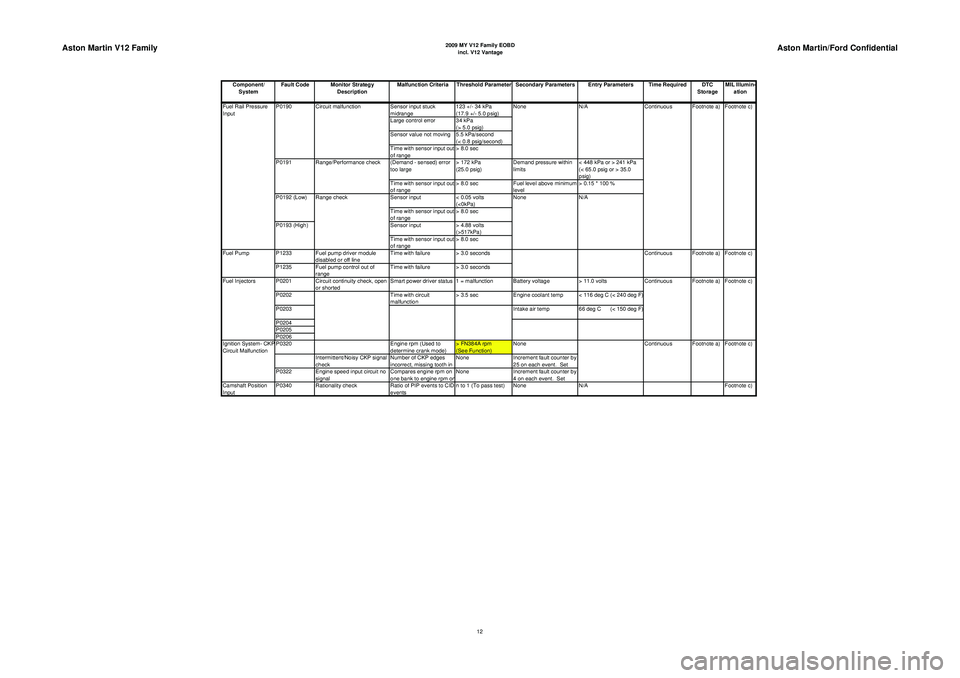
Aston Martin V12 Family
2009 MY V12 Family EOBDincl. V12 Vantage
Aston Martin/Ford Confidential
Component/ System Fault Code Monitor Strategy
Description Malfunction Criteria Threshold Parameter Secondary Parameters Entry Parameters Time Required DTC
StorageMIL Illumin-
ation
Sensor input stuck
midrange 123 +/- 34 kPa
(17.9 +/- 5.0 psig)
Large control error 34 kPa (> 5.0 psig)
Sensor value not moving 5.5 kPa/second (< 0.8 psig/second)
Time with sensor input out
of range > 8.0 sec
(Demand - sensed) error
too large > 172 kPa
(25.0 psig)Demand pressure within
limits < 448 kPa or > 241 kPa
(< 65.0 psig or > 35.0
psig)
Time with sensor input out
of range > 8.0 sec
Fuel level above minimum
level > 0.15 * 100 %
Sensor input < 0.05 volts
(<0kPa)
Time with sensor input out
of range > 8.0 sec
Sensor input > 4.88 volts
(>517kPa)
Time with sensor input out
of range > 8.0 sec
P1233 Fuel pump driver module disabled or off line Time with failure > 3.0 seconds
P1235 Fuel pump control out of range Time with failure > 3.0 seconds
P0201 Circuit continuity check, open or shorted Smart power driver status 1 = malfunction Battery voltage
> 11.0 volts
P0202 Time with circuit
malfunction > 3.5 sec
Engine coolant temp < 116 deg C (< 240 deg F)
P0203 Intake air temp66 deg C (< 150 deg F)
P0204
P0205
P0206
P0320 Engine rpm (Used to
determine crank mode) > FN384A rpm
(See Function)None
Intermittent/Noisy CKP signal
check Number of CKP edges
incorrect, missing tooth in None
Increment fault counter by
25 on each event. Set
P0322 Engine speed input circuit no signal Compares engine rpm on
one bank to engine rpm o
nNone
Increment fault counter by
4 on each event. Set
Camshaft Position
Input P0340 Rationality check
Ratio of PIP events to CID
events n to 1 (To pass test) None
N/A Footnote c)
Footnote c)
Fuel Rail Pressure
Input P0190
P0191
P0192 (Low)
P0193 (High)Range check
Range/Performance check
Fuel Pump Continuous
Circuit malfunction N/A
Continuous Footnote a) Footnote c)
None
None
N/A Footnote a)
Fuel Injectors Footnote c)
Ignition System- CKP
Circuit Malfunction Continuous Footnote a) Footnote c)
Continuous Footnote a)
12